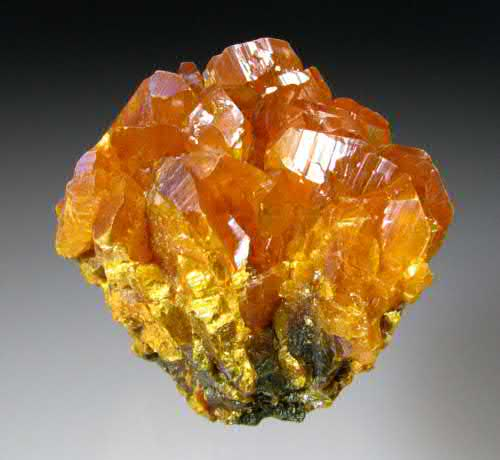Arsensulfid Chemische Eigenschaften,Einsatz,Produktion Methoden
R-S?tze Betriebsanweisung:
R23/25:Giftig beim Einatmen und Verschlucken.
R50/53:Sehr giftig für Wasserorganismen, kann in Gew?ssern l?ngerfristig sch?dliche Wirkungen haben.
S-S?tze Betriebsanweisung:
S20/21:Bei der Arbeit nicht essen, trinken,rauchen.
S28:Bei Berührung mit der Haut sofort abwaschen mit viel . . . (vom Hersteller anzugeben).
S45:Bei Unfall oder Unwohlsein sofort Arzt zuziehen (wenn m?glich, dieses Etikett vorzeigen).
S60:Dieses Produkt und sein Beh?lter sind als gef?hrlicher Abfall zu entsorgen.
S61:Freisetzung in die Umwelt vermeiden. Besondere Anweisungen einholen/Sicherheitsdatenblatt zu Rate ziehen.
Chemische Eigenschaften
Orpiment, As2S3, deep orange crystals to over 1 cm in a small group

Physikalische Eigenschaften
Yellow or orange monoclinic crystal or powder; a red allotrope modification also known; density 3.46 g/cm
3; melts at 310°C; boils at 707°C; insoluble in water; soluble in liquid ammonia and alkalies.
Occurrence
Arsenic sesquisulfide occurs in nature as the mineral orpiment. It is used as a pigment; in the manufacture of infrared-transmitting glass; in semiconductors and photoconductors; in pyrotechnics; in linoleum and oil cloth; for the removal of hairs from hides; and as a reducing agent.
Verwenden
manufacture of glass, particularly infrared-transmitting glass; manufacture of oil cloth, linoleum; in electrical semiconductors, photoconductors; as pigment; for depilating hides; in pyrotechnics.
synthetische
Arsenic sesquioxide may be prepared by heating arsenic trioxide with hydrogen sulfide:
As
2O
3 + 3 H
2S → As
2S
3 + 3 H
2O
Alternatively, it may be precipitated out from a solution of arsenous acid or arsenic trioxide in dilute hydrochloric acid by passing hydrogen sulfide into the solution:
2H
3AsO
3 + 3H
2S → As
2S
3 + 6H
2O.
Definition
Arsenic(III) sulfide (Arsenic tri-sulfide glass) is a glassy material. It is important as the window of a cell for a sample containing water.
Allgemeine Beschreibung
A yellow or red crystalline solid or powder. Combustible. Insoluble in water. Toxic by inhalation (dust) and ingestion.
Air & Water Reaktionen
Insoluble in water.
Reaktivit?t anzeigen
ARSENIC (III) SULFIDE is dissolved by alkalis and by hydrochloric acid (slowly). Decomposed by nitric acid. May react with oxidizing agents to generate heat and products that may be flammable, combustible, or otherwise reactive. The reactions may be violent. ARSENIC (III) SULFIDE reacts with concentrated solutions of chloric acid with incandescence [Mellor Supp. II Part I:584 1956]. Generates toxic gaseous hydrogen sulfide on contact with acids.
Health Hazard
(Acute and sub-acute poisoning are not common.) Repeated inhalation causes irritation of nose, laryngitis, mild bronchitis. Ingestion causes weakness, loss of appetite, gastrointestinal disturbances, peripheral neuritis, occasional hepatitis. Contact with eyes causes irritation. Irritates skin, especially where moist; if not treated, may cause ulceration.
Brandgefahr
Combustible material: may burn but does not ignite readily. Containers may explode when heated. Runoff may pollute waterways. Substance may be transported in a molten form.
Industrielle Verwendung
As
2S
3 (orpiment) and As
2S
2 (realgar) have been used as early as 2000 BC as drugs, for example, to cure cancerous tumours, ulcers and other diseases of the time. Later, Galen (130 200 AD) recommended the application of a paste of arsenic sulfide against ulcers.
Sicherheitsprofil
Confirmed human
carcinogen with experimental tumorigenic
data. A poison. Reacts violently with H202,
(m03 + S). When heated to
decomposition or on contact with acid or
acid fumes it emits highly toxic fumes of
S02, H2S, and As. Reacts with water or
steam to emit toxic and flammable vapors.
m?gliche Exposition
Arsenic trisulfide is used in the manufacture
of glass, oil cloth, linoleum, electrical semiconductors,
fireworks and used as a pigment.
Versand/Shipping
UN1557 Arsenic compounds, solid, n.o.s. inorganic,
including arsenates, n.o.s.; arsenites, n.o.s.; arsenic
sulfides, n.o.s.; and organic compounds of arsenic, n.o.s.,
Hazard Class: 6.1; Labels: 6.1-Poisonous materials.
Inkompatibilit?ten
A strong reducing agent; avoid contact
with oxidizers (such as perchlorates, peroxides, permanganates,
chlorates, and nitrates) and potassium nitrate mixed
with sulfur, since violent reactions occur. Water contact
forms hydrogen sulfide. Incompatible with acids, halogens.
Contact with acids or acid mists releases deadly arsine gas.
Waste disposal
Consult with environmental
regulatory agencies for guidance on acceptable disposal
practices. Generators of waste containing this contaminant
(≥100 kg/mo) must conform with EPA regulations governing
storage, transportation, treatment, and waste disposal.
Arsensulfid Upstream-Materialien And Downstream Produkte
Upstream-Materialien
Downstream Produkte

